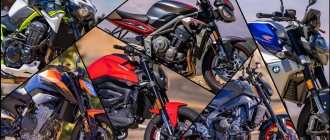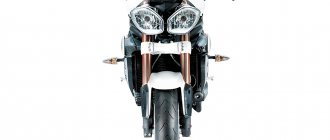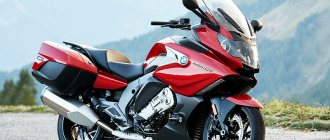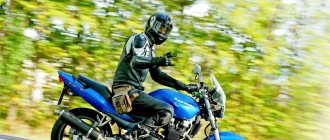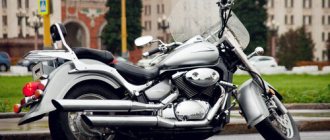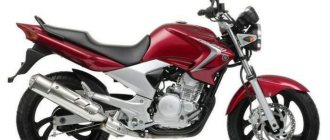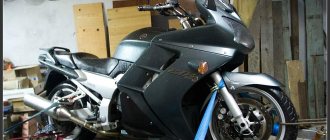| Kawasaki Ninja 650 (2017-2019) | Kawasaki Ninja 650 (2020+) |
the Kawasaki Ninja 650 sports touring motorcycle
was introduced in 2021 as a new generation of the ER-6 series, and in particular, the “sporty” modification of the Kawasaki ER-6F (aka Ninja 650R). Despite the separation of the motorcycle into a separate model, unlike the previous version, the new Ninja 650 was practically no different in technical terms - the most important change was the reconfiguration of the engine and exhaust to new environmental standards, due to which it lost 4 hp. maximum power. In all other respects it was practically the same motorcycle. The only major changes were visual improvements - a new appearance, new optics, dashboard and the design of some plastic elements.
Nothing new has appeared from electronic assistants either - ABS, slipper clutch and Assist & Slipper clutch.
The Kawasaki Ninja 650 is currently available in all major markets - Japan, Europe, North America, Australia.
In parallel with the “sports” model Ninja 650, a naked version is also offered - Kawasaki Z650.
For 2021, the Kawasaki Ninja 650 gets a makeover. The usual head light was replaced by LED optics, and the instrument panel became color TFT. The motorcycle also received a reshaped windshield, a new saddle, minor changes to the chassis (the wheelbase was reduced) and the Smartphone Connectivity system. Improvements were also made to meet new environmental standards.
Main competitors in the class:
- Honda CBR650R
- Yamaha R7 (2022)
Brief history of the model
- 2017 - start of production and sales of the model. First generation.
Model
: Kawasaki Ninja 650 + ABS (all regions).
Factory designation
: EX650JHF + EX650KHF.
- 2018 - no significant changes.
Model
: Kawasaki Ninja 650 + ABS (all regions).
Factory designation
: EX650JJF + EX650KJF.
- 2019 - no significant changes.
Model
: Kawasaki Ninja 650 + ABS (all regions).
Factory designation
: EX650JKF + EX650KKF.
- 2020 - restyling of the model. Second generation
.
Model
: Kawasaki Ninja 650 + ABS (all regions).
Factory designation
: EX650NLF + EX650MLF.
- 2021 - no significant changes.
Model
: Kawasaki Ninja 650 + ABS (all regions).
Factory designation
: EX650NMFNN + EX650MMFNN.
- 2022 - no significant changes.
Model
: Kawasaki Ninja 650 + ABS (all regions).
Factory designation
: EX650NNFNN + EX650MNFNN.
Winner: Triumph Trident 660 2021
Triumph Trident 660
Triumph Trident 660 2021 is the undisputed leader in comfort and ergonomics: controls, dashboard, excellent quality of finish. The excellent three-cylinder 660 cc engine is liked by literally everyone, even if it is somewhat inferior to the Yamaha. On the dyno chart, the Yamaha engine is the undisputed leader, but on the road its advantage is not so obvious. In addition, the Trident outperformed the Aprilia in terms of brakes and suspension, and thus rightfully took first place.
So, the motor. It’s average in terms of power, it works very smoothly and softly, it spins up easily to the main torque level and pulls very well at high speeds.
The ergonomics of the Triumph Trident 660 may not be perfect, but the riding position is neutral and comfortable for everyday city driving. When driving dynamically along serpentine roads, you feel the urge to sit closer to the steering wheel in order to more confidently load the front tire. The suspension is relatively stiff, but does not smooth out as well as that of the Tuono 660 and CBR650R.
Like the Aprilia, the Triumph Trident 660 exudes quality. Excellent finishing, lovely modern dashboard, and even the color options are very nice. If you try to describe the entire motorcycle in one word, then that word would be “smooth.” The engine is excellent both at low speeds around the city and in dynamic driving along serpentine roads, it runs smoothly, throttle response, and almost does not vibrate at any speed.
The Triumph Trident 660 is narrow in the saddle area, making it easy to reach the ground with your feet, making it ideal for beginners in this area. True, complete beginners should not start with any of these motorcycles; this is still a serious piece of equipment.
Triumph has been making triples for many years and the 660 is a great example of the importance of continuous improvement and what it can achieve. It is perfect - practically does not vibrate, even at high speeds, sounds great, produces excellent linear power. There are barely noticeable delays at small throttle openings, but it is very torquey at medium speeds and has absolutely no dips. At the top it runs out of steam before the Tuono, but still spins quite high and doesn't deflate too much.
It has excellent powerful brakes. At first I thought of writing that it was surprising to see reinforced lines, but to be honest, the rubber hoses on the other five models are more surprising. True, the information content is not ideal, but this is in contrast to the Brembo on the Aprilia. But if there is no contrast, it’s very good.
Two riding modes, Road and Rain, affect traction characteristics and traction control settings. Traction control, by the way, can be completely turned off, unlike ABS.
The chassis, equipped with an inverted fork, is composed and neutral. But the Trident isn't a Street Triple or a Daytona, it's a budget model that isn't very good on rough roads. However, of the six bikes, the Trident is the most composed, and in normal conditions it is absolutely stable, controllable and comfortable. For dynamic driving, as I said, I would like to slightly load the front wheel.
The design of the Triumph Trident 660 did not impress at first glance - it seems like a classic silhouette of a tank and headlights against the background of the features of a modern naked bike. It even seemed like some other headlight was suggesting itself, and then it dawned on me: this will turn out to be a Street Triple. Of the six, the Triumph LED light is the brightest and highest quality, even during the day. Its low beam is visible from more than a kilometer away.
So, first place goes to the Triumph Trident 660 2021. This is a comfortable, stylish and well-equipped motorcycle with an excellent three-cylinder engine. What also inspires respect is how well-developed Triumph motorcycles come out - the company never rushes to release new models, tests them thoroughly, and after release carefully monitors them for various glitches (which appear extremely rarely). Everything about the new Trident works as it should - as does most modern Triumph motorcycles.
It's not perfect, but it's more than worth the money, and it's also inexpensive to maintain. At this price, you can also afford heated grips, a quickshifter and a windshield. I would like to loosen up the fast compression smoothing a little, but otherwise the suspension is very good. At 6000rpm and 130km/h there is a subtle itch on the grips and it would be nice to have cruise control to give your wrists a break from that slight vibration. And this is probably where Trident’s shortcomings end.
Specifications
Technical characteristics of Kawasaki Ninja 650:
| Model | Kawasaki Ninja 650 |
| Motorcycle type | sports-tourist |
| Year of issue | 2017+ |
| Frame | steel tubular |
| engine's type | 2-cylinder, 4-stroke, in-line |
| Working volume | 649 cm³ |
| Bore/Stroke | 83.0 x 60.0 mm |
| Compression ratio | 10.8:1 |
| Cooling | liquid |
| Number of valves per cylinder | DOHC, 4 valves per cylinder |
| Fuel supply system | Injector, 2x 36 mm (with dual throttle valves) |
| Ignition type | digital transistor |
| Maximum power | 68.0 hp (50.2 kW) at 8000 rpm |
| Maximum torque | 64.0 Nm (6.5 kg*m) at 6700 rpm |
| Clutch | Multi-disc in oil bath, cable drive Assist & Slipper Clutch |
| Transmission | 6-speed |
| type of drive | chain |
| Front tire size | 120/70ZR-17 (58W) |
| Rear tire size | 160/60ZR17M/C (69W) |
| Front brakes | 2 discs, 300 mm, 2-piston calipers (EX650K – ABS) |
| Rear brakes | 1 disc, 220 mm, 1-piston caliper (EX650K – ABS) |
| Front suspension | 41 telescopic forks (non-adjustable), stroke - 125 mm |
| Rear suspension | pendulum with monoshock absorber (adjustable preload), stroke - 130 mm |
| Motorcycle length | 2055 mm |
| Motorcycle width | 740 mm |
| Motorcycle height | 1135 mm 1145 mm - from 2021 |
| Wheelbase | 1450 mm 1410 mm - from 2021 |
| Seat height | 790 mm |
| Minimum ground clearance (clearance) | 130 mm |
| Acceleration 0-100 km/h (0-60 mph) | 4.4 sec[1] |
| Maximum speed | 198 km/h[2] |
| Gas tank capacity | 15.0 l |
| Motorcycle weight (curb) | 190 kg 192 kg – Ninja 650 (ABS) 193 kg – Ninja 650 (ABS), from 2021 |
Kawasaki
And I also read a short test drive: I perfectly understand the organizers’ intention: where else, if not in sunny Spain, can they organize a presentation and road test drive of the new Kawasaki Ninja 250R sports bike. But the weather had its own gloomy thoughts on this matter. Barcelona greeted us “cordially” with rain and everyday traffic jams. Representatives of the “green” company also added to the sentiment. They said that the previous group of journalists, for safety reasons, were deprived of riding on the winding roads of Catalonia, limiting themselves to a tour of Barcelona due to heavy rain. The beginning was encouraging... After lunch, the weather cleared up, the sun was shining, and in order to somehow pass the time before the press conference, I decided to examine the “mini ninja” displayed in the hotel lobby. I think no one will argue - the motorcycle is beautiful. Full-size chopped plastic, a double headlight a la Batman's eyes, a sharp sporty tail and petal brake discs at the front and rear - all this gives the device a unique charm. Faceted rear view mirrors and turn signals in white plastic attract attention and look like external tuning. At the same time, yellow turn signals are available as an option. The model presented in the makeshift showroom was fully equipped with various bells and whistles: there was a tinted high Double Bubble windshield, a passenger seat cover that added a sporty look to the Ninja, and even side sliders. There are no difficulties with choosing a color; you just have to decide which of the two you like better - “Lime Green” or “Ebony”. One can say simply about the instrumentation and controls of the motorcycle: they are straightforward and very comfortable. The instruments are analogue, the glass is practically glare-free, the scales and numbers are made quite large. For me, it would be better to place the tachometer in the center rather than the speedometer, but from the point of view of the developers, this is some element of passive safety for beginners. The switches on the clip-ons are arranged according to the classic canons - everything is convenient, everything is at hand and is located intuitively. In the entire appearance of the motorcycle, only the muffler “can” causes slight doubt; its chrome-plated impressive “carcass” looks like a foreign body. Let's give a hint to caring Kawasaki 250R owners: now you can order small and neat carbon and titanium mufflers for your pet. One disc at the front is enough for the eyes. The rear disc, like the front, is of a petal type. The white turn signal comes stock. In the evening, during the presentation, the organizers paid special attention to the geometry course. In the diagram, three points of support for the motorcyclist on the bike: saddle-clip-ons-pegs, showed the difference in fit with its older brother - the ZX10R. Surprisingly, given the small size of the “quarter”, the seating position is designed for a pilot over 180 cm tall. Well, let’s take it for a ride and test it. The journalists’ question to engine engineer Araya-san sounded almost in Russian: “How much does he eat?” Colleagues in the workshop reacted with heated discussion to the numbers voiced by the Japanese translator. We decided to believe. In conclusion, marketers of potential users of the small “sport”. These are novice motorcyclists, women and middle-aged city residents. These groups are united by a common desire to own a sporty, but “soft” motorcycle with a bright appearance, beautiful sound and the charisma of a real superbike. Can not argue. It was not possible to start the test day on a positive note: it started raining right in the morning. We weren’t worried about the photo shoot - after all, it wasn’t raining, but a gurney “with all the money” obviously wouldn’t work. On the other hand, wonderful conditions for real tests! The fireworks were lit by the instructor leading our group of six little Ninjas through the streets of Barcelona. At some point, a minivan braked quite dynamically in front of him, and the Spaniard grabbed the front brake in surprise - the lowside did not linger. Here I would like to say that driving around the capital of Catalonia during rush hour is not an entirely simple matter. We had to stay tight so that cars and traffic lights didn’t “cut us off” from each other. What I mean is that, having gathered in single file behind the “episode” leader, we all managed to slow down without a hint of extreme behavior, and pressing the brakes also seemed like a difficult task. Passive safety again? While “lacing up” in the aisles, I remembered the declared dry weight of the car. A considerable 154 kilograms are actually quite easily shifted during maneuvers and settle down during braking. Getting the motorcycle to stall in the first two gears or lifting the front wheel at the start is a completely unrealistic task. However, some particularly sadistic testers performed hints of such numbers, but at the same time they made full use of the wet asphalt and mercilessly “raped” the clutch. I was impressed by the shape of the tank and the fit. It was hard to believe in the universality of the landing announced at the presentation, especially considering our own “meter-ninety”. However, somehow the Japanese managed to make the impossible possible, even the knees fit perfectly into the recesses of the tank. Banzai! Having rolled out the planned route through a beautiful European city, we gathered at the next point in order to install a GPS device and set off at our own risk along the winding mountain roads of Catalonia. Already at the beginning of the journey on the motorway, it became clear that for a pilot of my size it was almost impossible to push the needle to the maximum marked 200 km/h. It started to blow me away at 140, and at 160 I gave up. Perhaps the tall glass offered would have helped here, but most likely, I shouldn’t have grown up like that. The winding road abruptly slowed down our pace, my fellow travelers became despondent, and I, who by coincidence was traveling last, increasingly understood that this situation did not suit me. Choosing the moments, and as you understand, the “friendly” engine does not contribute to instant teleportation, I overtook my colleagues one by one and rushed to check the “green Yoda”. I admit, even though the music played for a long time and your humble “fraer” managed to “dance” a lot of people on the serpentines, it all ended with sparks from the titanium sliders of the test pilot’s overalls. A classic and absolutely fabulous lowside brought down the “Jedi” and me on a rather steep descent in a 120° turn. But all's well that ends well: the pilot escaped with a broken finger (I take this opportunity to say hello to the protection, especially the one-piece racing suit), and the motorcycle with several scratches on the fairing, a small crack there and a torn off turn signal. That's all! Excellent crash test. Needless to say, the test subject started up with a kick. After a close inspection of the crash site, it became clear that the cause of the not very shameful, but accident, was not aquaplaning, but ordinary “car spots” that became a kind of ice on the wet asphalt. Upon investigation, it turned out that a small “stud” can still be inserted by “shoe makers” - the Kawasaki 250R is equipped with tires from an unknown manufacturer with an abbreviation of three letters that do not pop up in the “broken” memory. In this regard, urgent advice: if you buy a motorcycle, immediately “change it” into something decent - it will pay off! The rest of the journey was more than calm. Already at the approach to Barcelona, the mocking sun popped up again, but the mood was already peaceful, the motorcycle was purring contentedly, the pilot was enjoying the ease of control and the culture of behavior on European roads. I was so relaxed that I almost ran off to Girona, driving right through the entire Barça. It turned out that in numerous tunnels, losing contact with the satellite, GPS was unable to warn about the required turn. The rider came to his senses only when the roadside landscape became clearly not urban and signs “To Girona” began to appear more and more often. Praise be to civilization, satellites and gadgets - I pressed a couple of buttons and the miracle technology almost itself took me to the hotel entrance. I almost forgot about the burning question. Regarding fuel consumption, I would say that the Ninja does not consume it at all. We were given motorcycles fully fueled, through the city and serpentine roads, according to the odometer, we drove about 150 km. On the way back, the organizers prepared a refueling station, but after opening the tank lid, most of us were stunned by the amount of gasoline splashing and rushed to the hotel without wasting time on “feeding”. It is difficult to give exact figures, but it seems that the “baby” is not capable of drinking more than 5 l/100 km. Although we should not forget about the rainy conditions of the race and, accordingly, the riding style is far from drag racing. Until recently, the bulk of motorcycles traveling on domestic roads were Japanese second-hand ones from 400 cm3 and above. But with each season, the layer of motorcycle users who choose “two wheels” from the position inherent in a pragmatic European city dweller becomes more and more noticeable. Ease of control in urban conditions and fuel consumption are at the forefront. The guys from Kawasaki managed to calculate the “people's need” for such a motorcycle and were ahead of their competitors in the “Japanese four” by at least a season. It is not surprising that the quota allocated for sales in Russia was snapped up like hot cakes even before the equipment arrived in motorcycle dealerships. The Ninja 250R looks, sounds and drives much more than it costs.
Summary of six naked bikes
Well, Triumph is the undisputed leader in this comparison. But are its other participants so bad? No and no again! Even the underdog, the old Suzuki SV650, has a lot of fans for its engine. The new Honda CB650R will appeal to those who respect Honda, love in-line fours and are not too worried about the somewhat weak character of this engine. The baby Kawasaki Z650 will be greatly appreciated by short riders; there is nothing to say about the MT-07, it is a wildly popular motorcycle. And the fact that the Aprilia Tuono was higher in the chart is more a merit of Aprilia than a defect of Yamaha.
Well, you already know the rest (about Trident). This is wine.
